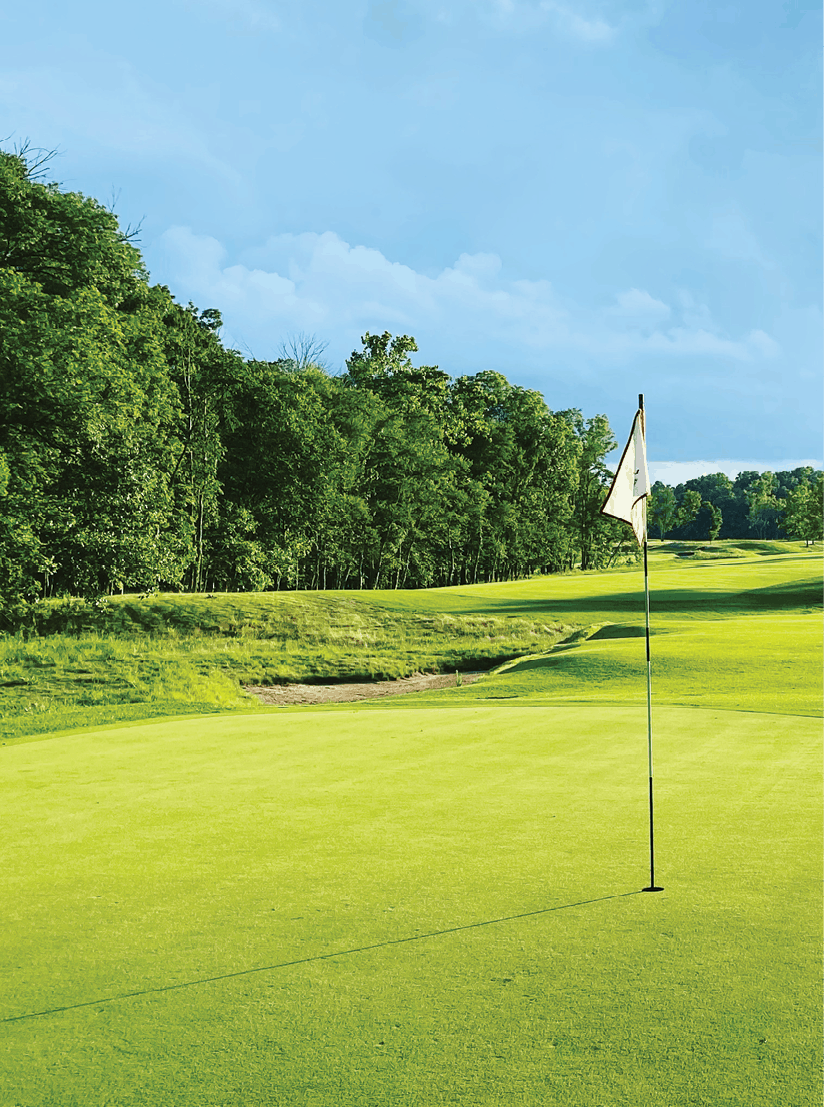
Tucked into the southern Indiana woods sits the back tee of the 18th hole at The Pfau Course at Indiana University, a spot where the future of Transition Zone agronomics and, perhaps, championship golf intersect.
From the Kentucky bluegrass surface, the hole bends right. The strong will land drives on more than two acres of Meyer zoysiagrass covering the fairway. The timid will play second shots from under trees on the left or go ball searching in the woods on the right.
Anxiety reigns the entire way.
And that’s just the start of a 517-yard hole playing into a prevailing wind. The approach shot must carry a native area consisting of Irish Links and fine fescue, then stop on a punchbowl T-1 bentgrass green within a natural amphitheater. Five bunkers filled with brown river sand lurk between more wispy grasses guarding the green.
The par 4 hole was designed by Steve Smyers, a Florida-based architect with an accomplished playing record who believes high-level golfers must earn happy endings.
“Real championships,” says Smyers, standing on the tee during a humid Sunday afternoon in August, “shouldn’t be decided with a wedge on the last hole.”
While a movement to make courses easier for all comers dominates the current construction and renovation market, a client occasionally asks an architect to design a course capable of providing what Smyers calls “a thorough examination of one’s abilities.” The client in this case proved to be a major university seeking a course tough enough to test the best players in the Big Ten and beyond without overextending a maintenance budget or environmentally straining the most secluded spot on a 40,000-student campus.
Unlike the heavily populated regions of Indiana, the southern portion of the state features subtly enchanting terrain. Smyers, who started his own design firm in 1983, begins the August course tour by effusively praising the Bloomington, Indiana land. “It’s the best site I have ever had to work with,” he says.
The Pfau Course, named in honor of lead donors Ned and Sue Pfau, was built on the same ground as Indiana University’s existing golf course, a pedestrian course opened in 1957 and best known as the spot where Jack Nicklaus won the 1961 Big Ten Championship. Smyers and a team from Clarke Construction moved just 80,000 cubic yards to build the new course. Construction commenced in 2018, a year that included 70 inches of rain — much higher than the 48 annual inches Bloomington averages — and the university opened the course to the public this past June.

The course will bolster the recruiting efforts of the Indiana men’s and women’s golf teams and serve as a social and recreational hub for students, faculty and staff, alumni, university decision-makers and the Bloomington community. Being involved in the building, unveiling and now daily maintenance of the course represents a highly personal assignment for superintendent Anthony Robertson, a Bloomington native who played his first round of golf at the old Indiana University course.
“I could never imagine anything like this being here,” Robertson says. “Being a part of it and seeing it at the end, sometimes I get … It’s hard for me, because I look at everything that’s wrong and I want to fix everything that’s wrong. But there are the moments where I can stand back and look at this golf course and think, ‘I could never imagine it being this good, not even freakin’ close.’”
Robertson left the head superintendent position at nearby Bloomington Country Club, where his brother Levi is the current superintendent, for the Indiana job in 2016. Chatter about the university building a new course with zoysiagrass fairways attracted Robertson to the Pfau Course. Robertson established himself as one of the industry’s zoysiagrass gurus by elevating the fairway conditions at Bloomington CC.
“I would put him up against anybody in the country that knows zoysiagrass,” says senior assistant athletic director and Pfau Course general manager Greg Bishop, a golf construction and management veteran who returned to the industry in 2015 to oversee the university’s golf course development efforts. “That was a plus for what we wanted to do. He told me he would only come here if we were doing zoysiagrass. I don’t know if he was going to come if we were going to do bentgrass.”


Robertson, who maintains a close relationship with Bishop, laughs at his supervisor’s comment: “I like to be a minimalist.”
Bloomington, latitude 39.1653 north, rests in the upper portion of the Transition Zone, yet the city’s three regulation golf courses feature zoysiagrass fairways. The City of Bloomington recently converted 27 holes on its Cascades Golf Course to Meyer zoysiagrass.
This course doesn’t need a 40-person crew. It’s a great big golf course and it’s a huge dramatic golf course, but, in reality, if you have a 15-person crew in the summer, we can really dial this golf course in.” — Anthony Robertson
“The first time I hit off zoysiagrass I was 14,” Robertson says. “I had no idea why we would have any other grass here other than Meyer zoysia. For this climate and these soils, it’s what we need.”
Smyers, a past member of the USGA Green Section committee, designed a course with 32 acres of zoysiagrass fairways atop heavy-clay soils. The slow-growing nature of Meyer zoysiagrass meant fairways were sodded to meet deadlines. Smyers, Bishop and Robertson are confident that zoysiagrass will yield long-term economic and environmental rewards. “It’s money up front,” Bishop says. “But if you look at the long term, it’s really a no-brainer.” The total cost of the project, including a new clubhouse, was $12 million.
Robertson projects an annual chemical and fertilizer budget on fairways around $20,000 and he envisions the surfaces being mowed “at most” three times per week as the course matures. Other aspects of the design should minimize the amount of labor required to keep the course in tidy condition for daily play. Only 80 acres of turf require mowing, with Kentucky bluegrass rough providing a buffer between fairways and native areas. Bunkers are plentiful — close to 150 dot the property — but Smyers says they are intended to play as hazards that fit the site, thus the brown sand.
“This course doesn’t need a 40-person crew,” Robertson says. “It’s a great big golf course and it’s a huge dramatic golf course, but in reality, if you have a 15-person crew in the summer, we can really dial this golf course in.”
Labor restrictions tied to COVID-19’s impact on the university represent the biggest short-term conundrum facing the course. At one point this past spring, with the opening approaching, Robertson, Bishop and a mechanic were the only employees maintaining the course. The size of the crew has slowly increased, although it hasn’t reached its initially-budgeted size. The Indiana men’s and women’s teams are practicing on the course as they prepare for the return of Big Ten athletics.
Exhilaration overtook exhaustion when the course opened. The Hoosiers finally have a home to match many Big Ten peers. The zoysiagrass, bentgrass, bluegrass and fescue create distinct hues, giving the course a pleasant walk-in-the-woods vibe. A new medical center first noticeable when walking up the 11th fairway represents the only glimpse of campus life while on the grounds.
At 447 yards, the 11th is one of just three par 4s under 450 yards from the back tees. The par-71 layout can be stretched to more than 8,000 yards for championship play, but Smyers quickly notes that immense hole yardages offer setup flexibility. “The people who play this course are going to become better players by playing it,” he says. “If you can play here, you can play anywhere.”
Once disruptions caused by COVID-19 pass and the course matures, a significant championship will likely be won — or lost — on the 18th hole.
“It would be a dream of mine to host a big event here,” Robertson says. “The stencil is out there and we get closer every day.”

Explore the October 2020 Issue
Check out more from this issue and find your next story to read.
Latest from Golf Course Industry
- Audubon International announces newest leadership appointees
- Southern golf trifecta
- Sports for Nature Framework gains new signatories
- Camiral Golf & Wellness upgrades Stadium Course
- Troon selected to manage The University Club of Milwaukee
- Kafka Granite adds new business development manager
- GCSAA celebrates 10-year anniversary of collaboration with Congress
- DLF launches new seed enhancement solution





